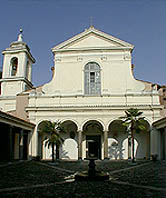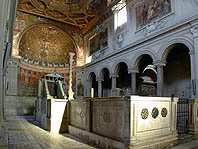Other Important Basilicas
St. Clemente
 (Basilica di San Clemente). In this best preserved of medieval basilicas (4 C AD) one experiences an amazing whirl through history in the different layers of Rome.
(Basilica di San Clemente). In this best preserved of medieval basilicas (4 C AD) one experiences an amazing whirl through history in the different layers of Rome.
Deep in the earth under the church is a Roman street with two houses which date back to Republican times (B.C). One became a Temple of Mithras, god of a bloodthirsty religion brought by soldiers from Persia. Members of this sect believed Apollo ordered the god Mithras to kill a bull without spilling a drop of blood. However, a scorpion bit the dying bull, and the blood spilled out, thereby bringing evil into Apollo's perfect world (like the snake in the Garden of Eden).
In accordance with this myth, Mithraic worshipers sat on these stone benches and watched the priest kill a bull in front of them - as the carving on the stone altar shows - and then sprinkled the blood over themselves. (A particularly expert way of killing a bull, shown in some ancient bas-reliefs, is to put one's fingers into its nostrils, making it easy to pull back its head as the flesh inside the nose is very sensitive, and then slice its neck). This religion, which once rivaled Christianity, was outlawed in 395 AD.
In typical Roman fashion, an Imperial Roman house, belonging to the cousin of Emperor Domitian (81-96 AD), was built on top of the Mithraic temple.
The lower Christian church, already mentioned in 392 AD by St. Jerome, was restored later in the 8C and 9C. In 1084 during the Sack of Rome, it was destroyed by Robert Guiscard with the marauding Normans, who had already settled in Sicily. Visible in this church are some wonderful 6C frescoes (533-535, Pope John II). One is of St. Clement's exile and death, another of Sinnius, Prefect of Rome, blinded when coming to arrest his wife attending Mass here.
Pick out St. Leo IV with a square halo (meaning he was still alive at the time of the painting). This, and the exciting finds below it, were discovered by an Irishman, Father Mullooly, in 1857. A later discovery in 1967 on this level is a total immersion baptismal font. It shows how prevalent was the rite of going into the water up to one's neck, especially with adult converts, to wash their sins away when being baptized in the early years of the Church.

In 1989 Professor Guidobaldi discovered the 6 C sacristy where Pope Gregory I (died 604 AD) prepared himself for Mass. The floor is an attractive inlay of colored marbles, a technique predating the intricate Cosmatesque floors of the 12 C.
The upper church was started during the time of Pope Pascal II (1108 AD). Built exactly over the lower one. Salvaged from the old church are the superb marble choir stalls and the screens behind them, with the high altar and bishop's throne, still in use in the center of the church. The 12th Century Cosmatesque floor and mosaic spiral candlestick complete the picture.
12th Century mosaics on the back wall behind the altar are replete with pascal sheep (the flock), and doves (the apostles) amid leafy bowers. Christ is on a Triumphal arch with Saints Peter and Clement and their boats, and the river of Paradise is depicted flowing from the Cross.
14 C fresco on the Apse wall; three 15 C tombs on the left and right aisle.
![]() In St. Catherine's Chapel are frescoes (pre-1430) by Masaccio, founder of the Renaissance, and his teacher Masolino. A true gem.
In St. Catherine's Chapel are frescoes (pre-1430) by Masaccio, founder of the Renaissance, and his teacher Masolino. A true gem.
Ignore the less interesting 18 C frescoes on ceiling and wall, and the busy Baroque stucco work. Outside the church is a charming colonnaded courtyard, which was the medieval entrance of the old church. The Irish Dominicans have taken tender loving care of this marvelous Basilica since 1667.
|
St. Clemente
History 88-97 AD. Under Emperor Trajan, St. Clement, 4th Pope of Christendom, was martyred by drowning in the Black Sea, after being tied to an anchor and thrown overboard. |
Piazza San Clemente - Via S. Giovanni in Laterano (Map L 8)
Once the sanctuary for an ancient mystic sect, the neo-pythagoreans who believed in the transmigration of the soul, this structure dates back to the first century of the Empire.